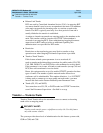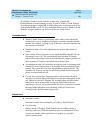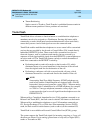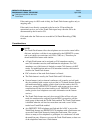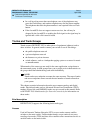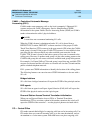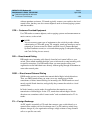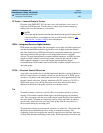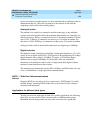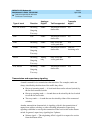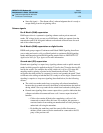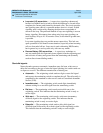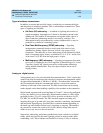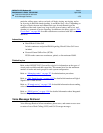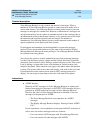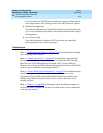
DEFINITY ECS Release 8.2
Administrator’s Guide
555-233-506
Issue 1
April 2000
Features and technical reference
1568Trunks and Trunk Groups
20
receive one of these start dial signals, it can be administered to send digits after an
administered interval. (This time-out interval is the amount of time that the
originating switch waits before sending digits.)
Analog tie trunks
The number of tie trunks in a connection and the technology of any multiplex
systems used in the facilities affect the maximum data transfer rate. Generally, for
transfer rates up to 300 bps, a connection can have 5 tie trunks in tandem. For data
rates of 301–2,400 bps, a connection can have up to 3 tie trunks in tandem. For
data rates of 2,401–4,800 bps, a connection can have up to 2 tie trunks in tandem.
Analog tie trunks used in unswitched connections can support up to 9,600 bps.
Digital tie trunks
The digital tie trunk is a high-speed and high-volume trunk interface to a T1 or E1
carrier. It uses a digital signal level 1 (DS1) protocol. By multiplexing 24 64-kbps
digital channels onto a single 1.544-Mbps T1 carrier, or 32 64-kbps digital
channels onto a single 2.048-Mbps E1 carrier, DS1 offers an economical
alternative to the analog tie trunk as well as a high-speed fully digital (without
modems) connection between the switches.
The maximum per-channel data rate for DS1 is 64 Kbps, and DS1 trunks can carry
voice, voiceband data, or high-speed data communications.
WATS — Wide Area Telecommunications
Service
Outgoing WATS service allows calls to certain areas (“WATS bands”) for a flat
monthly charge. Incoming WATS trunks allow you to offer toll-free calling to
customers and employees.
Applications for different trunk types
To help you select the right type of trunk for a specific application, the following
table gives you an overview of key characteristics of different trunk groups.
Remember that all analog trunks can carry only voice and voice-grade data.



